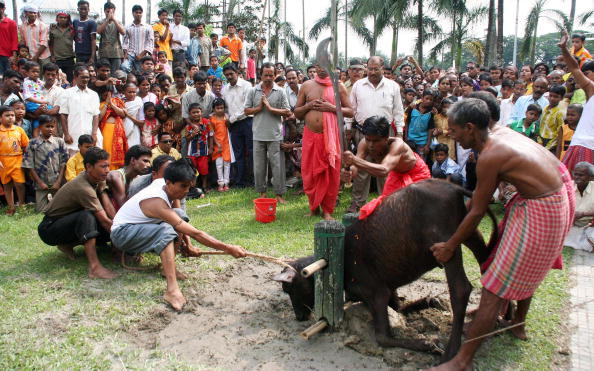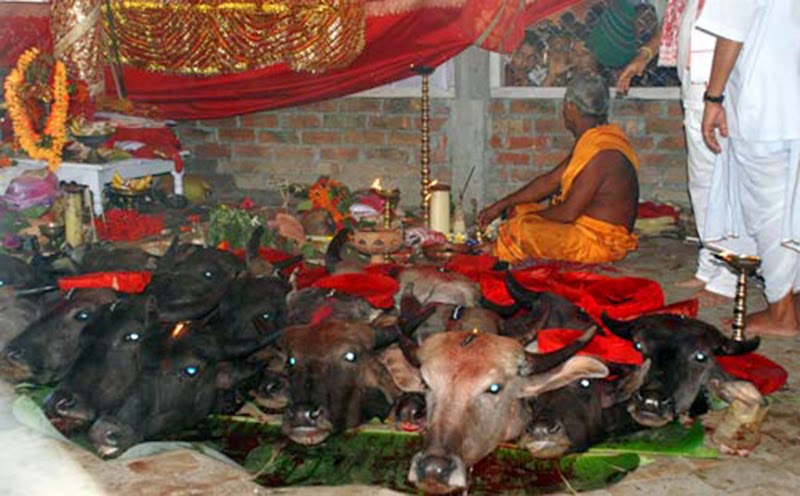
Living in the 21st century is highly conflicted. It is a century which is seen as giving rise to novel perspectives and approaches at the expense of traditional ideologies and beliefs. In such a contemporary scenario, one cannot help but observe new waves of debates being intermeshed with the older ones.
In the light of such socio-cultural context, there exists a stark contrast between the upholding of cultural beliefs on the one hand, and the absolute debunking of these ideas on the other hand.
Far from the maddening crowd, in the quiet countryside of the Singhbhum belt of Jharkhand, lies a cluster of villages which fall under the erstwhile princely state of Seraikella. Strongly influenced by Tantric traditions and the ritualistic beliefs of the cult of Shakti, this region becomes alive during the long expanse of the Durga Puja festivities. Interestingly, a particular ritual practice called Pashu-Bali (sacrifice of animals) has long been a matter of debate and discussion in the country. People have debated a lot about the ethical aspects revolving around this practice as it undeniably involves sacrificing the animal, something which is deemed as extremely “unethical” and “inhumane” by many people. In spite of all these discourses, this particular practice is still an endearing aspect of the festivities for the natives.

On a sultry October afternoon, when one visits Chhelkani, which is a small, yet historically significant village, in the Seraikella District, one can probably find people busy with preparations for the DurgaPuja festivities. This festival is referred to as the ‘Asina Puja’ by these natives, which adds a local flavourto it. This terminology is employed because according to the Hindu calendar, this festival falls in the month of Ashvin. Unlike most other regions of the country, where a rigorous ten-day observation of Navratri fasting is held, the rural regions of this belt are an exception. Most of the celebrations here are centred on three significant days –Saptami, Ashtami & Navami—and mass ritual sacrifice of animals is practised across this three-day period.
In a world where people are surrounded by discourses of veganism, especially in states like Delhi, what one finds in some parts like the rural areas of Jharkhand is an entire narrative of superstition and belief. Tantric chants and incantations are generally witnessed after the ritual sacrifice of the Bodas (Male goats), the

Non-vegetarianism, according to the vegans is an essentially ‘savage’ lifestyle as it deals with literally eating animals. Vegetarianism, on the other
Interestingly, it seems that these debates of culture vs modernity have given rise to a continuum, due to which the current scenario is changing a bit. On 27th September, 2019, the Tripura High Court passed a ruling judgement that “No person including the State shall be allowed to sacrifice any animal/bird within the precincts of any of the temples within the State of Tripura”. This 500-year old tradition of animal sacrifice taking place in Tripura is similar to the one happening in Jharkhand. Therefore,Jharkhand isn’t just one place where this kind of animal sacrifice is being practiced. The ruling has made it clear that immediate installation of CCTV cameras must take place, especially in two main temples where animal sacrifice is being in form for about 500 years –Chaturdas Devata temple and Devi Tripureswari temple. However, the Tripura government is quite disturbed with this kind of ruling
as it is a complete upturning of their cultural beliefs and traditions.
And, in the meantime, while all of us will be completely immersed in debates and discussions about culture, modernity, veganism and traditional ideologies, the October Sun would be dawning upon the Seraikella belt, with people eager to indulge in the frenzy of the Durga Puja festivities, something which will be of a recurring nature till these debates of veganism somewhere, change such a culturally inherent scenario.
Author: Somnath Pati

